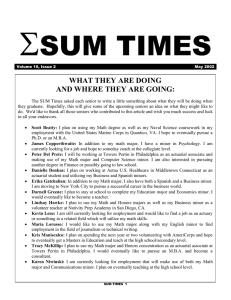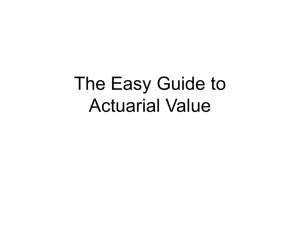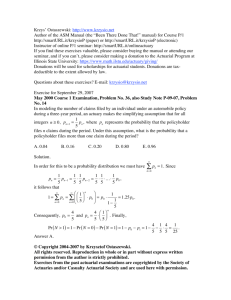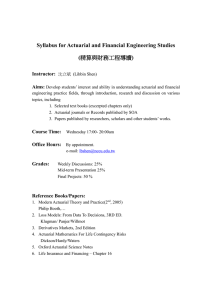2008 Revised Qualification Standards Southwest Actuarial Forum Catherine Taylor, FCAS, MAAA
advertisement
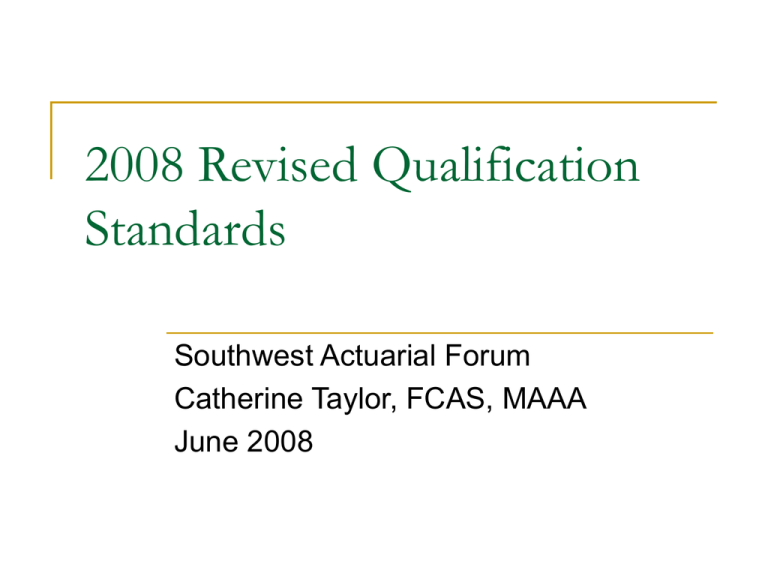
2008 Revised Qualification Standards Southwest Actuarial Forum Catherine Taylor, FCAS, MAAA June 2008 Background Code of Professional Conduct requires members of the American Academy of Actuaries (AAA) to Adhere to high standards of the actuarial profession in conduct and practice Perform professional services only when qualified to do so, and Meet applicable qualification standards. Let’s Talk about the Code of Conduct 14 Precepts which “identify the professional and ethical standards with which we must comply to fulfill our responsibility to the public and the actuarial profession.” Applies to all members of CAS, SOA, CCA, & ASPPA whether or not a member of AAA. Pop Quiz! Name one of the Precepts? Also Applies to CAS Students CAS Code of Professional Ethics for Candidates Code of Conduct modified for non-members Also covers Exam Discipline Application signature acknowledges adherence Effective with 2008 exams This is sooo last year, … Actuaries were required to meet the Qualification Standards if they were issuing Prescribed Statements of Actuarial Opinion (PSAO). PSAO is a statement of actuarial opinion or communication which is issued about Laws & Regulations Actuarial Requirements Accounting Requirements Qualification Standards To issue a PSAO, an actuary had to meet General Qualification Standards, including Basic education (exams or alternative) Experience (sufficiently experienced to apply proper techniques) Continuing education For Basic Education & Experience, Ultimately… Can you look in the mirror and say you are qualified? Continuing Education Requirements Obtain sufficient continuing education to maintain current knowledge in the applicable practice area. Casualt y Life Health Pension Previous Requirements Annual average of 12 credit hours in each two consecutive calendar years. At least 50% of the hours in “Organized Activities” Remaining hours in “Other Activities” Up to 25% from professionalism topics. Organized Activities Meetings of local or national actuarial organizations Other meetings, seminars, & programs with actuarial content Teleconferences or electronic conferences Time spent taking exams successfully Listening to tapes if accompanied by live presentations or discussion leaders Other Activities Independent study Listening to tapes of seminars If content is relevant Committee participation (including inhouse committees) Studying for actuarial exams Writing papers Preparing presentations Correspondence course Here’s What’s New! Broadened definition of what constitutes a Statement of Actuarial Opinion Basic Education Requirement & Experience essentially unchanged, but more specific Significant increase in CE hour requirement Broadened definition of what qualifies for CE Statements of Actuarial Opinion “Opinion expressed by the actuary in the course of performing actuarial services and intended to be relied upon by the person or organization to which the opinion is addressed.” What are Professional Actuarial Services? Opinions Findings Client or Employer relying on Recommendations Advice In Other Words… Pretty much everything we do! SAOs can be… Internal company communication if contains actuarial content intended to be relied upon Usually written, but could be oral May or may not be a public document Not everything an actuary communicates is an SAO - must have actuarial content! Examples of SAO SAO Reserve opinions Rate filing Expert testimony Ratemaking opinion Pricing opinion Management reports on actuarial topics May Contain SAO Slide presentation Speech Phone conversation Data call certification Congressional testimony New Basic Education & Experience Member of AAA, CAS, SOA, CCA, ASPPA or other IAA-member organization 3 years responsible actuarial experience Work requiring knowledge and skill in solving actuarial problems Knowledge of law on SAO defined in Code of Professional Conduct New Continuing Ed Requirement At least 30 hours each year of relevant continuing education (24 hours in 2008) At least 6 of the 30 hours must be Organized Activities At least 3 of the 30 hours must be on professionalism topics Hours met in the year preceding the SAO What Is Relevant? Does it broaden understanding of the work an actuary does? Does it expand knowledge of related disciplines that bear on an actuary’s work? Does it facilitate entry into a new practice area? It can also be business skills. (3 hour cap) What are General Business & Professionalism Topics? Business Skills Client Relationship Presentation Communication Project Management Personnel Management Professionalism Studying, reviewing, or providing input on Serving on Exposure Draft ASOP Code of Professional Conduct ASB Professionalism Committee Ethics Training What Counts as Organized Activities? Interaction with other actuaries working for different organizations Conferences Seminars Webcasts In-person or on-line course Committee work In-house meetings only count if there is an outside speaker. What Counts as Other Activities? Reading actuarial literature or other material on relevant technical or professional topics Writing papers Listening to tapes of seminars Relevant in–house meetings Studying for actuarial exams Drafting actuarial exams Preparing for or speaking at a CE activity Again with the mirror… You must be able to look yourself in the mirror and say this qualifies! What Else? 50 minutes is a CE hour and fractional portions earned at a rate of 60/50 (1.2). Hours can be carried over 1 year i.e. 90 minutes is 1.8 hours not 1.5 hours For 2008, hours above 24 in 2006 & 2007 For new members, hours spent studying count for CE in the next year. How Do I Let Others Know I Am Qualified? SAOs need to include an acknowledgement of qualification. Company actuaries should be notifying their management about their qualification. Should be done annually. How Do I Keep Track of Everything? Records are required to be maintained Must be kept for 6 years At a minimum include Date of the CE Credit hours obtained Brief description of the subject matter Possible Spreadsheet Name Record of Continuing Education 2008 Activity Credit Sponsor Date(s) Event Subject Matter Type Hours Total Organized Activities Credit Hours 0 Total Other Activities Credit Hours 0 Total CE Credit Hours 0 POP QUIZ! #1 Does this session count for CE and if so, which category and how much? Organized Activities & Professionalism 1 hour #2 EMB America and Pinnacle periodically put on1 hour webinars. Do they count for CE and if so, which category and how much? Organized Activities 1.2 hours #3 Would a 50 minute internal meeting summarizing information your boss learned at an external class on communication skills count for CE and if so, which category and how much? Other Activities & General Business I hour #4 Would a 50 minute session on ERM with the AVP, Enterprise Risk Management at your company count for CE and if so which category and how much? Other Activities 1 hour #5 Would a 1.5 hour Advanced Training session at your company with IIHS’s Kim Hazelbaker count for CE and if so which category and how much? Organized Activities I.8 hours Where Is All of This Information? AAA website www.actuary.org Click on Code of Conduct on the left CAS Website www.casact.org Click on Standards & Guidelines on the left I urge you to read these carefully! Questions?
